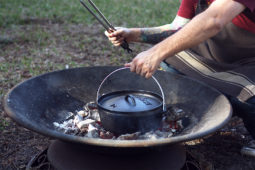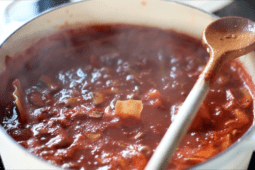How to: Make a DIY Rolling Grill Cart and BBQ Prep Station

If I could, I’d never not grill in the summer time. Breakfast, lunch, dinner, midnight snacks … all of ’em would be over the open flame. It’s the flavor, sure, and those attractive grill marks, but what I really love about grilling season is just cooking outside. Why hang out in the kitchen next to the stove when you can be in the summer air, surrounded by lightning bugs and tiki torches, with music in the background?

So, I decided to take both the preparation and the cooking steps outside, and build this DIY grill cart and rollable prep station. It’s got a large, counter-height top for slicing and prepping foods, two storage shelves to keep things organized, and collection of hooks and features to make for a great cooking experience.
Oh! And get this
If you want to learn to make your own, you can sign up for this free DIY Workshop at your local Home Depot. It’s available at Home Depot locations all across the U.S., and it doesn’t cost a cent to learn.
The DIY Grill Cart Workshop takes place this Saturday, June 20, 2015 from 10:00 – 11:30AM. You can find more details and register at the Home Depot Workshops page.
If you live near Seattle, Washington, I, Chris Gardner from ManMade, will be teaching the workshop at the Seattle Bitter Lake Store (Store #4706 11616 Aurora Ave N.) If you’re in the area, this is an awesome opportunity for me to meet and collaborate with ManMade readers, and I’ve love to hang out with you and use some power tools for a day.
So, head to the Home Depot DIY Workshops page to sign up, and we’ll see you on Saturday.
Materials
- Two cedar 2x6s, eight feet long
- Three cedar 1x3s, eight feet long
- Four cedar 1x4s, eight feet long
- Four three-foot lengths of 2″ aluminum angle, 1/8″ thick
- Four 3″ casters, two locking and two regular
- 20x 3 1/2″ galvanized or stainless decking screws
- 40x 3″ galvanized or stainless decking screws
- 1 box 2″ panhead screws
- Spray primer and paint (I used a 2-in-1 product)
- Wood finish (I used Watco Danish Oil)
- Assorted stainless hooks, paper towel bars, bottle openers, etc
Tools
- Circular saw or miter saw
- Cordless drill and driver
- Random-orbit sander or sand paper
- Thread cutting oil for drilling metal (in the plumbing aisle at Home Depot)
- Safety glasses, dust mask, and gloves
Note: I made my project using cedar, and designed it to live outside and last for many grilling seasons to come in the Pacific Northwest weather. If you know yours will stay in a garage or covered patio, you can save some money by using pine or fir rather than cedar.

1. Build the top: The top is constructed from cedar 2x6s, cut to 36″ in length. The completed size is 36 x 22 1/2″. The 2x6s are set evenly on top of a frame, spaced a bit to allow the wood to expand and shrink with the weather, and to allow any water to drip through, like a picnic table top.
The key to using dimensional lumber for great looking projects? Sandpaper. Take your time to smooth out any milling marks, and then sand the natural roundovers on the edges to be consistent and smooth.

2. Assemble the frames. The structure of the cart consists of three frames constructed from cedar 1×3. Cut two pieces to 30″ long, and two to 17″ for each shelf frame (six of each size for the whole project). Attaching with butt joints makes these frames into an “apron” to mount the top and the shelves. This is smaller than the top, which allows for more working spaced without increasing the overall dimension of the cart.
Once the frame rails are cut, assemble them into a finished size of 30 x 18 1/2″. Then, use the 3 1/2″ screws to attach the top (note the spacing of the 2x6s here). The top is now finished.

3. Make the shelves. There are lots of ways to create shelves for storage depending on your needs. I decided to make mine from slats of cedar 1×4. They’re cut to 18 1/2″ long, and I used eight for each, requiring two eight-foot long 1x4s per shelf.

Like the top, these are assembled with screws through the bottom, so there’s no visible hardware. I sanded each shelf carefully and also created a slight bevel, or chamfer, on each edge for a finished look.

4. Make the Legs. The legs are 2″ aluminum angle, which you can find in the weldable steel section of the home improvement store. You could also use steel, but it will be much harder to drill and cut. My aluminum is 1/8″ thick, and plenty strong for this project. We put 300 lbs of weight on this thing just to test it, and had no problems whatsoever with strength. Plus, the aluminum won’t rust as easily if the paint chips.
To lay out the screw holes, I made a little jig from some 2″ wide scrap cedar. I spaced the holes 1″ apart, and then flipped it when marking the other side of the 90° angle. This guarantees all my screws are evenly spaced, and that none of them will hit another when attaching from the other side. At this point, you’ll need to make the decision about where your middle shelf will sit. If you have an ash bucket or cooler or other large item you want to store on bottom level, be sure to account for that in your shelf spacing.
You can drill into metal with an ordinary drill and drill bits. Just use a punch, awl, or a nailset to make a little divot so your drill bit doesn’t wander, and start slow. Be sure to wear appropriate safety gear to protect yourself, and use a little oil when drilling to keep the bit and the material cool.
Note: I bought my aluminum angle in 8″ lengths and cut them to size, so my cart would be a comfortable working height with the top and casters in place. They ended up 30″ long. You can use 3′ lengths, but your cart will be taller overall. You can cut aluminum angle (but not steel) with a carbide blade in your miter saw, or use a hacksaw with a bi-metal blade. An angle grinder will also work, but if you own an angle grinder, you probably know that already 🙂

Once cut and drilled out, prime and paint the legs. Take your time and do multiple thin coats for even coverage and no drips.

5. Assemble the final cart. Now, all you gotta do is put things together. Start by placing the legs around the bottom shelf and screw into place to create the final shape. Then, attach the middle shelf, using a tape measure and level to make sure it hits the hardware holes at the right place. Lastly, attach the top.

Whenever you attach metal to wood, be sure to use pan head screws instead of those with a flat, countersunk head. This will pull the material together and use the strength of the hardware and the wood to hold everything in place.

Okay, confession time: here’s where I had to adjust a little. I centered my screw holes on the 2″ aluminum, which means the 1×3 material actually wasn’t thick enough to accept the screws. So I had to add a little block of scrap 2×6 from the top to give the screws something to bite into. This also made a wide platform to attach the casters to the bottom. No big deal. You could avoid this step by drilling your screw holes 3/8 from the edge instead of centered, but it took me all of two minutes to make the extra cuts.
Lastly, attach the casters to the bottom. Use the two locking casters on the long side you expect will face the grillmaster most often for easy access.

6. Finish the Grill Cart. I finished my cedar with Danish Oil, which you can find in the stain and paint section of Home Depot. This finish cures in the wood, making it harder, and is easily to reapply. Danish Oil is considered food-safe once it has fully cured in the wood… or at least as food safe as cedar will ever be. I always plan to use a cutting board for food prep, so I focused on making the wood long lasting outdoors. Follow the manufacturer’s directions, and allow to cure fully.

Then, add some accessories, like hooks for the grill tools, and, of course, a bottle opener.
Now, light the charcoal, and let’s get grilling.








Happy Summer, and remember: if you want to learn to build your own, head to the Home Depot DIY Workshops page to sign up. If you’re in Seattle, I’ll see you on Saturday!

Thanks to Home Depot for sponsoring this post and making ManMade a partner for the 2015 DIY Workshop series. Thank you for supporting the brands that make ManMade possible.








